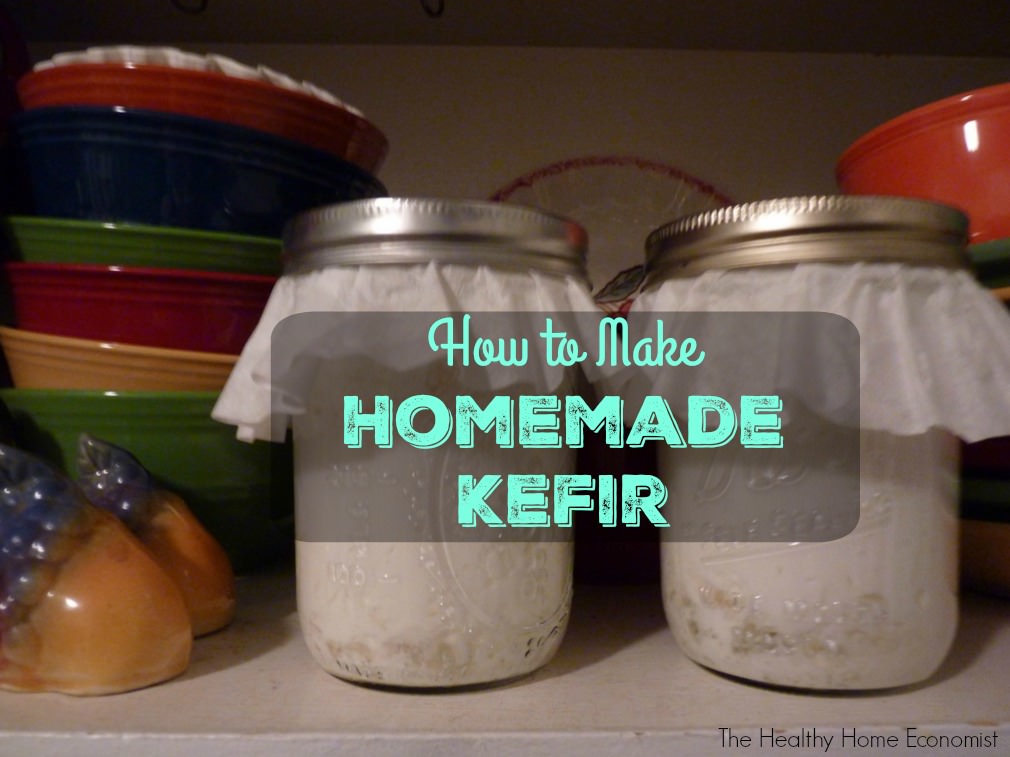Table of Contents[Hide][Show]
How to make homemade kefir the traditional way by fermenting on the counter for 24 hours with farm fresh milk.

I prefer homemade kefir to yogurt because yogurt only has 2-5 strains of beneficial bacteria None of these aggressively attack and destroy pathogens in the gut like the probiotics in kefir do.
By the way, kefir is pronounced ku-feer (not kee-fer or ke-fer).
Kefir made at home has dozens of beneficial bacterial strains as well as several beneficial yeasts. Kefir compared to yogurt is no competition. Kefir is much more beneficial for gut healing.
The one catch is that you need to learn how to make kefir yourself!
Commercial kefir brands typically have far less microbial strains and are not fermented long enough to have the same benefits.
Homemade Kefir Benefits
In a gut that is dominated by pathogens and candida overgrowth (as in someone who has taken many rounds of antibiotics and other prescription drugs over the years and/or eats primarily processed foods), yogurt tends to have only a temporary beneficial impact.
As mentioned earlier, homemade kefir has about 30 beneficial strains of bacteria and yeasts that do aggressively recolonize the gut by destroying pathogens.
As a result, kefir has the potential to permanently alter the gut environment for the better whereas yogurt does not.
The best way to make homemade kefir is to obtain live kefir grains from a friend. They grow slowly over time and extras can be given away (or even eaten as a live probiotic).
Avoid using powdered starter for kefir. It has little to no therapeutic value.
If you cannot find any live grains in your community, you can mail order them.
Other Types of Kefir Made at Home
If learning how to make other types of kefir interests you, check out this video on how to make water kefir.
This video plus recipe on how to make coconut milk kefir is helpful if you wish to make a dairy-free version of the milk-based kefir below.

Homemade Kefir Recipe
Easy recipe for homemade kefir fermented on the counter for 24 hours to maximize beneficial microbial strains for gut healing.
Ingredients
- 1 quart raw milk preferably grass-fed
- 1 wide-mouthed mason jar
- live kefir grains
Instructions
-
Pour the raw milk into a clean glass mason jar leaving about 1 inch at the top. You can use cold milk right out of the refrigerator if this is more convenient. Gently stir in live kefir grains. Roughly one-quarter cup of grains is sufficient to ferment the entire quart.
-
Screw on the lid and leave on the counter at room temperature for 24 hours. Over this time, you will see the milk slightly separate and thicken.
-
The kefir should be ready after 24 hours of fermentation time. If powder culture was used, you can use the kefir as is. If live kefir grains were used, gently strain them out to use again with the next batch of raw kefir.
Recipe Video
Recipe Notes
You do not need to rinse live kefir grains before using again. Rinsing them slightly weakens them in my experience.
Homemade kefir will last many weeks in the refrigerator, but its flavor will get stronger over time.








Hello there
I’m on the GAPS diet and Dr Natasha recommends keeping the jar at 110 degrees for 24 hrs to make sure the bacteria work effectively. If it’s just left on the counter will all the milk sugar have been metabolised by the good bacteria after 24 hrs? I want to make sure I don’t have any sugar left in my Kefir. Leaving it on the counter looks easier than heating, but I don’t want to risk ingesting any sugars. Please could someone help me?
Hi Sarah,
How do I get the kefir Live-culture grain if I don’t know anyone who has one to spare?
Hi Viviana,
I went to simplykefir.com and ordered mine. It is working great. Or if you want, when I get to the point where I can spare some (maybe a month or more, not sure yet) if you pay me shipping, I’ll send you some via usps.
Hi Becky,
Thank you for your response, for a moment I thought “Are my questions posting” ? No response from blog host – “too busy” . I would be interested in your gracious offer. I’ve never shared food with a stranger over the internet so, I’m a little curious as to how I would gauge the authenticity or quality/effectiveness of the grain? Is there some way to identify a good quality kefir grain from a “bad” one? I appreciate your insight and willingness to share! 🙂 I’ve only been getting my meats, dairy,etc from a GF farmer for about 2 1/2 months? I absolutely love the culture of bartering and exchanging services on an “Honor System” its restorative to my soul.
In Unity,
Viviana
You can order live kefir grains here: culturedfoodlife.com/store/product/donnas-kefir-grains/
Can I use raw cream to make this?
Hi Sarah,
I posted a question 5 months ago and I’m still waiting for an answer. I purchased the Kefir grains back in October when I read your post and have had them here waiting until I hear back from you. I see others have similar questions. Would you consider taking a moment to answer? I’ll repost the question here.
“I want to make coconut kefir since we never drink milk. If I need to refresh the milk kefir grains every few times in milk — and I have to buy some milk for only this purpose — I’d want to find the most economical way to do this since the milk will be disposed after refreshing the kefir grains. I’m assuming I can not buy one of those little lunch size milk cartons of milk because of it being ultra pasteurized. What would be the best solution for my problem?”
Thank you, Stacey
Hi Stacey,
Sorry to jump in on your question, but I thought maybe after researching this in minute detail, I might try to help. Any chance you have someone, a friend, relative, who would give you some milk and want the kefir? That sounds like it would be the BEST answer to me, since you’d not have to pay for the milk, and your kind friend would greatly benefit from some fresh kefir! I know if I lived near you, I’d give you milk and take the kefir! (let me know if you live in Idaho, LOL)
Good luck, Becky
Is it ok to use slightly soured raw milk to add to the grains to make your kefir?
b’h
I have the same question as Sarah:)
Hi Sarah,
Great video. I have a question around the long-term storage of the milk kefir grains. You mention putting them in a jar of milk in the fridge. A number of sites tell you for storage over a few weeks, you MUST dehydrate or rinse them and store them in the fridge in water. I much prefer your recommendation. I don’t want to dehydrate and then wait for rehydration. And putting the grains in water sounds like starving the poor things. 😉 Would you mind addressing the pros/cons of all the various processes and when/if you would recommend one process over the others?
I am confused on how the kefir grain is reused over and over again. I am very new to this. Can raw goat milk be used? We have a milking goat.
Hi Sarah,
I want to make coconut kefir since we never drink milk. If I need to refresh the milk kefir grains every few times in milk – and I have to buy some milk for only this purpose – I’d want to find the most economical way to do this since the milk will be disposed after refreshing the kefir grains. I’m assuming I can not buy one of those little lunch size milk cartons of milk because of it being ultra pasteurized. What would be the best solution for my problem?
Thanks Stacey